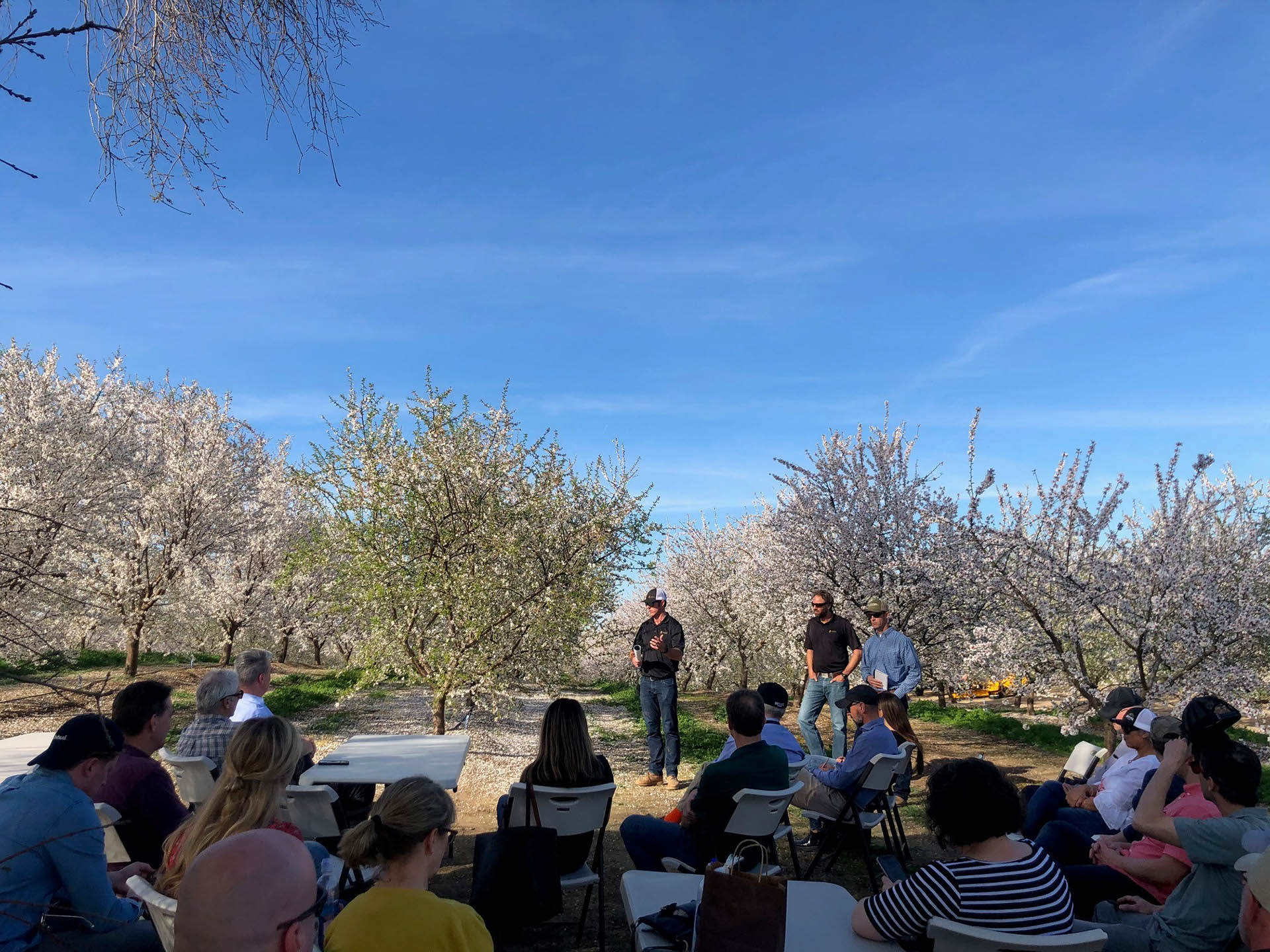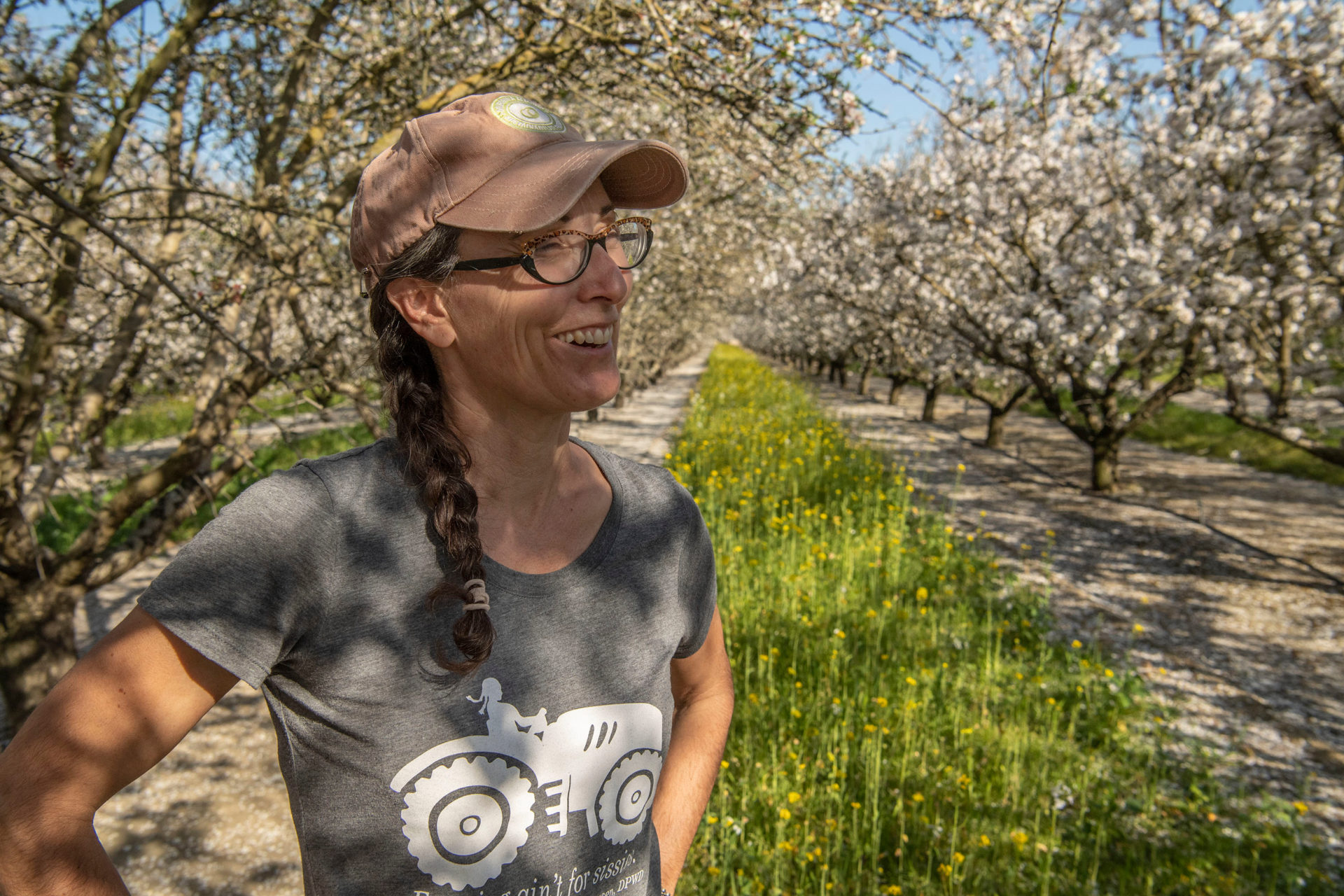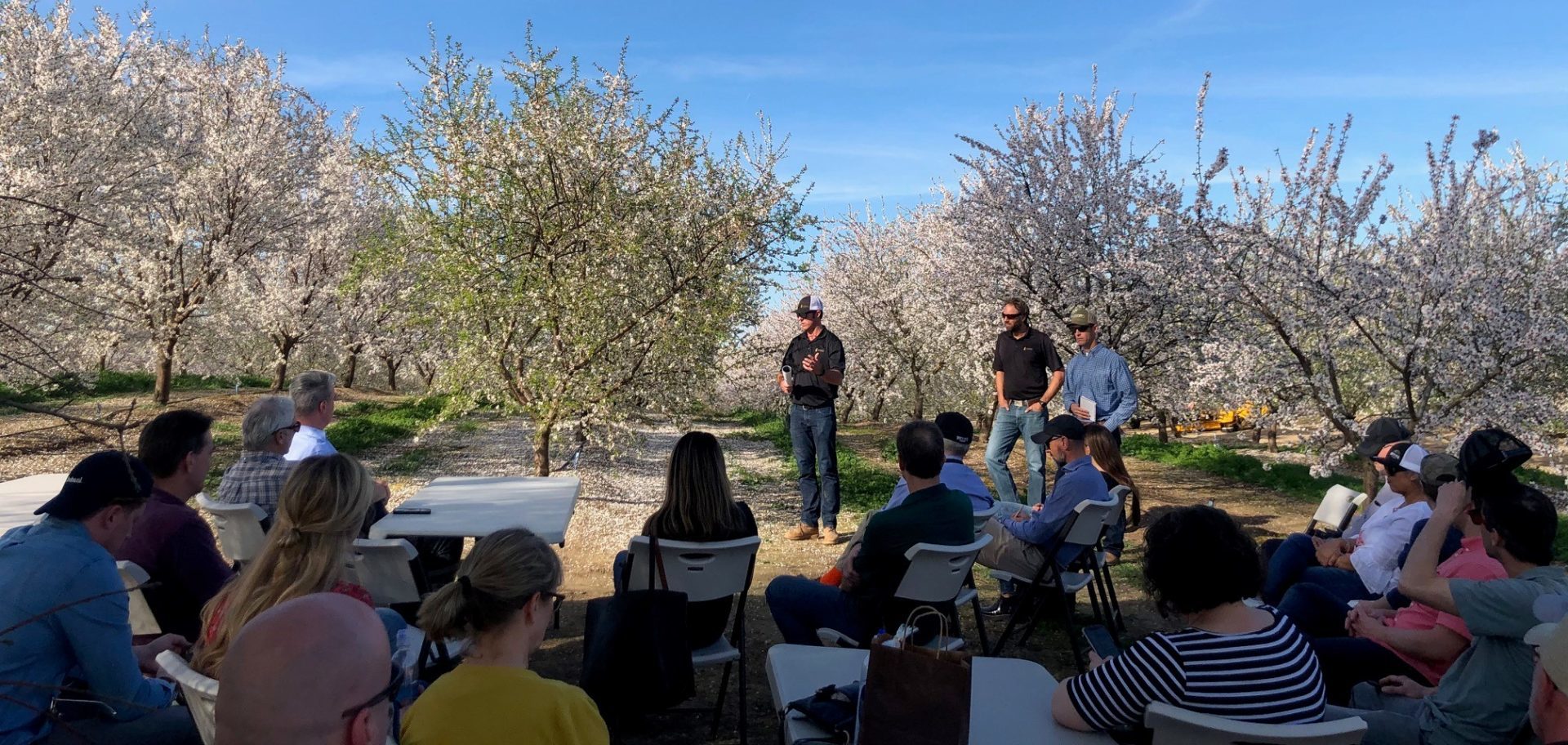
This February, the Almond Board of California (ABC) hosted more than 20 influential supply chain stakeholders at its first-ever Almond Sustainability Tour. These stakeholders represent food companies from across the globe, including General Mills, Campbell Soup Company, Coca Cola and Seeberger, and hold various roles within their company’s sustainability programs, from leaders of entire sustainability programs to directors of supply chain and sourcing to heads of global procurement.
Led by ABC’s Trade Stewardship and Sustainability teams, the tour was aimed at providing key decision makers in the supply chain with a first-hand look at the California almond industry’s responsible growing practices. Over the course of three days, attendees visited four almond growers and one handler to learn about the unique benefits and complexities of growing almonds in California, from water availability and pest challenges to Whole Orchard Recycling. These insights provided sustainability professionals with greater understanding of the challenges facing growers, and the broader industry, in providing a high-quality product to consumers worldwide.
“Prior to the Coronavirus pandemic, not a day went by without the word ‘sustainability’ in the headlines, as more and more consumers are seeking transparency in how the products they buy make their way through the supply chain. For food brands who use California almonds in their products, this consumer trend means it is imperative to understand the almond industry’s responsible, sustainable growing practices and how we are documenting them,” said ABC’s Associate Director of Trade Stewardship Harbinder Maan.
CASP Shines Amongst Sustainability Professionals
On day one of the tour, attendees visited fourth-generation almond grower Eric Genzoli at his family’s operation in Turlock. Genzoli, a graduate of ABC’s Almond Leadership Program, shared his passion for environmental stewardship and explained how his desire to preserve the land for future generations motivated him to complete all nine modules in the California Almond Sustainability Program (CASP).
Launched in 2009, CASP is a nine-part self-assessment that helps growers compare current practices against industry standards and identify areas of improvement across their operations. Through the CASP online portal (SustainableAlmondGrowing.org) growers can assess their practices, determine opportunities for further efficiencies and utilize free decision-making tools, all while meeting regulatory requirements.
To gain an even greater understanding of CASP and how it relates to almond organizations’ sustainability initiatives, the group visited Monte Vista Farming Co., a grower and processor in Denair. Monte Vista CEO Jonathan Hoff led the group on a tour of his facility while explaining CASP’s vital role in sharing the industry’s responsible growing practices with businesses who need that information to satisfy consumer demand.
Hoff, an ABC Board member, was one of the first handlers to participate in the CASP Supply Chain program, which officially moved from a pilot program to an industry-wide effort in 2020. Hoff explained how the program allows growers to share their data anonymously, in aggregate, with Monte Vista, who then can share it with their buyers. This helps food companies –like those represented by the sustainability professionals –meet their sustainability goals and answer questions from consumers who are demanding more information about how their food is grown.
When speaking with Hoff, the group was most impressed by the type of reporting CASP generates. Food companies must be able to measure progress toward increasingly sustainable growing practices for each of their products in a way that is meaningful to the supply chain and consumers; information from CASP can do just that for almonds. Representatives from SureHarvest, the organization ABC partnered with to develop and maintain CASP, and the SAI Platform, the organization that benchmarked1 CASP and translated the almond-specific program to international sustainability standards, were also on hand to demonstrate how industry data gathered and analyzed by CASP can help food manufacturers meet sustainability goals and help companies address growing demand from conscious consumers who want to know how their food is grown.
Tour Highlights Industry’s Almond Orchard 2025 Goals
In addition to CASP, the California almond industry’s Almond Orchard 2025 Goals – which work together with CASP – were on full display during the tour. The 2025 Goals build off decades of previous industry achievements and are a tangible example of the California almond community’s commitment to continuous improvement.
 Established by the industry in 2018, these goals state that by 2025, the California almond industry commits to:
Established by the industry in 2018, these goals state that by 2025, the California almond industry commits to:
- reduce the amount of water used to grow a pound of almonds by an additional 20%,2
- achieve zero waste in the orchard by putting everything grown to optimal use,
- increase the adoption of environmentally friendly pest management tools by 25%, and
- reduce dust during harvest by 50%.
“In the last few years, the fastest growing area of interest from the food industry has been sustainability,” said Maan. “We knew nothing would be more impactful than inviting these sustainability professionals to California to see first-hand how dedicated and invested the almond industry is in sustainability.”
To learn about the industry’s progress toward the 2025 Water Goal, the group visited Blom Ranch in Modesto, where they met grower Nick Blom and ABC Senior Manager of Field Outreach and Education Tom Devol. Blom took the sustainability professionals on a deep dive into the history of groundwater recharge in the California almond industry and shared the outcomes of recharge research trials that the University of California (UC) Davis and Sustainable Conservation conducted on Blom’s property in 2016.
Blom and Devol showcased various irrigation methods as well as ABC’s Almond Irrigation Improvement Continuum, addressed how different soil types necessitate different irrigation strategies and explained how precision agriculture and advanced irrigation technologies are helping growers attain “more crop per drop” in their orchards.
From there, the group stopped in Ceres to speak with grower Christine Gemperle on three other key areas of consumer interest for food companies, which are also relevant to the 2025 Goals – bee health, soil health and zero waste.

Gemperle spoke to the relationship between almond trees and honey bees, as well as the industry’s efforts to protect pollinators, as detailed in its Five-Point Pollinator Protection Plan.3 The Almond Board also invited spokespersons from the Pollinator Partnership and Project Apis m. (PAm) to speak alongside ABC Chief Scientific Officer Josette Lewis about the various ways in which these organizations are working closely to promote honey bee health and reinforce the importance of the Honey Bee Best Management Practices4 among the almond growing community. They highlighted ABC’s work with PAm’s Seeds for Bees program, which encourages the use of cover crops to increase the amount and diversity of bee forage in California almond orchards.5 Gemperle, who has participated in the Seeds for Bees program for six years since its inception shared how she’s seen cover crops planted in her orchard support biodiversity and provide variety in bees’ diets over the years, allowing the bees to be healthier and the hives to be stronger once they’ve left her orchard.
In addition to pollinator health and cover crops, Gemperle discussed her experience with Whole Orchard Recycling,6 which involves grinding old almond trees into small chips, spreading the chips across a bare orchard floor and disking them into the soil (about six inches deep). This form of “regenerative agriculture”—that which increases biodiversity, enhances ecosystems and enriches the soil—was a big hit among the visiting sustainability officers, whose companies and customers increasingly want to hear how commodities are finding responsible uses for their by-products and working to achieve zero waste.
That afternoon, the group met with grower Brian Wahlbrink of Sperry Farms in Denair, who explained how California almond growers employ environmentally friendly integrated pest management on their operations, as well as California guidelines and regulations. Wahlbrink’s pest control advisor (PCA) joined him in the orchard to provide perspective on the importance of PCA’s relationships with almond growers and their integral role in the industry.

At the end of his discussion, Wahlbrink, who chairs ABC’s Harvest Workgroup and sits on ABC’s Board of Directors, showed the group Sperry Farms’ harvesting equipment and explained the harvesting process to them.
To round out the second day of the tour, ABC introduced the group to Bill Lyons, CEO of Mapes Ranch and former Agricultural Liaison to Gov. Gavin Newsom. Lyons, who served as Secretary of Food and Agriculture under Gov. Gray Davis from 1999 to 2004, spoke to California’s regulatory environment and the state’s engagement in key issues impacting agriculture. His perspective as a long-time grower, rancher and voice for the ag community shed new light on the challenges faced by California almond growers.
Learning Beyond the Orchard
On the final day of the tour, sustainability professionals visited the U.S. Department of Agriculture (USDA) Agricultural Research Service (ARS) research facility near Berkeley to learn more about ABC’s collaboration with USDA-ARS on almond coproduct research. The visit offered another example of how the almond industry is investigating new, higher value uses for everything an orchard grows.
During a tour of the facility, the group learned of potential high-value uses for almond hulls and shells that go beyond the traditional uses of feed and bedding for livestock, such as using sugar extracted from hulls as an ingredient in beer or cider, or using torrefied almonds shells to strengthen recycled plastics. Tour attendees were impressed by the ingenuity of this ongoing research and pleased to see the almond industry so vested in the area of zero waste.
Providing plenty of boots-on-the-ground experiences and learnings from various almond stakeholders, ABC’s Almond Sustainability Tour offered sustainability professionals a vast amount of information about the California almond industry’s journey toward continuous improvement via a more responsibly grown, safe and sustainable crop.
“In holding this tour, ABC provided a forum for growers, handlers and the broader almond industry to share research insights and information on CASP and the 2025 Goals, information that food companies can, in turn, use to help meet the needs of their customers,” said Maan.
In addition to the orchard and facility visits, ABC and sustainability professionals participated in a facilitated discussion led by ABC Director for Sustainability and Environmental Affairs Gabriele Ludwig about the challenges large food companies face and the ways organizations like ABC can help them achieve sustainability goals. Top among each sustainability professional’s wish list for the industry was increased grower participation in CASP, as greater participation will allow for more broad storytelling and transparency among consumers making purchasing decisions based on how sustainably their food was grown. The professionals also asked ABC to continue providing information on the industry’s soil health and water use efficiency initiatives so they may share those details with interested customers. This discussion provided greater perspective of the demands placed on sustainability professionals by their companies and customers, giving ABC staff insights on how they may support these professionals to ensure they have the information they need to continue meeting their companies’ sustainability goals and drive consumer demand of almond products.
“Helping connect these large companies with the grower and handler community is just one more way ABC strives to support demand and foster greater collaboration for the California almond industry,” Maan said.
Sources
1 For more on this global benchmarking effort, visit http://newsroom.almonds.com/content/california-almond-sustainability-program-recognized-globally-by-sai-platform.
2 In the past 20 years, California almond growers have reduced the amount of water it takes to grow one pound of almonds by 33%, thanks to research-based farming improvements and the adoption of water-saving technology. Source: University of California, 2010. Food and Agriculture Organization of the United Nations, 2012. Almond Board of California, 1990-94, 2000-14.
3 The California almond industry announced its Five-Point Pollinator Protection Plan in January 2020. For more information, visit newsroom.almonds.com/content/california-almond-community-announces-five-point-pollinator-protection-plan.
4 Visit Almonds.com/Pollination for more information on the Honey Bee Best Management Practices.
5 For more information on the Seeds for Bees program, visit http://www.projectapism.org/seeds-for-bees.html
6 For more information on Gemperle’s experience with Whole Orchard Recycling, visit http://newsroom.almonds.com/content/considering-whole-orchard-recycling-keep-mind-0.















